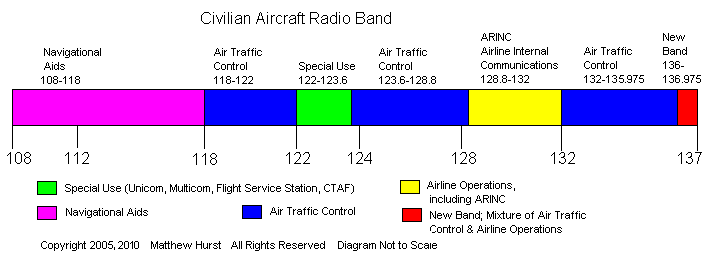| |
Radio Scanner Guide |
  |
Part 3C: Civilian AircraftListen to commercial airlines, private aircraft, helicopters, blimps, hot air balloons, and other aircraft in the civilian aircraft band with your scanner! Airborne planes can easily be heard from well over 100 miles away due to their height, so you will be able to enjoy plenty of action on your radio scanner even if you don't live near a major airport. If you do live near an airport, you will be able to hear transmissions directly from the tower as well! The Civilian Aircraft Band is located between 108 to 137 MHz and is found on scanners in Categories 2, 3, 4, 5, and 6 (all categories, except category 1) in this guide. Radios in Category 2 are usually the least expensive since they lack advanced features needed to hear some other listening topics. It is shown in blue in the radio spectrum diagram below. 
Listening to AircraftAt most small airports that don't have control towers, most action will occur on the UNICOM frequency, typically 122.900 or 122.950. Other less common UNICOM frequencies are 122.700, 122.725, 122.800, 122.975, 123.000, 123.050, or 123.075 MHz. At larger airports that have control towers, most airports have the following types of channels: ATIS (Automatic Terminal Information Service)- This frequency has a recorded message that plays continuously, giving pilots necessary flight information including the weather and runway information. Clearance Delivery - The pilot uses this frequency to notify a controller of his flight intentions and to receive flight instructions and clearance for take-off. Ground Control - The ground controller tells the pilot which taxiways to use to arrive at the correct runway. Tower - Once he arrives at the correct runway and is prepared for takeoff, the pilot will contact the Tower Controller and seek permission to enter the runway. Eventually the Tower Controller will give him clearance and departure instructions. Once the aircraft leaves the airspace of the airport, the pilot will be handed off to a controller at a TRACON (Terminal Radar Approach Control) or an ARTCC (Air Route Traffic Control Center, commonly called Air Traffic Control). TRACON (Terminal Radar Approach Control)Congested airspace around busy airports, typically those serving major cities, is controlled by a TRACON facility. These facilities control aircraft arriving, departing, or traversing their airspace. Typically, a TRACON facility's airspace will be much larger than an individual Tower's airspace and may cover several airports. A TRACON will typically have several frequencies for approach and departure. Often different frequencies are used for different directions. After an airplane leaves a TRACON facility's airspace, it will be handed off to an ARTCC. ARTCC (Air Route Traffic Control Center)When outside the airspace of an airport or TRACON, an airplane is under the control of an ARTCC. All airspace in the United States is under the control of one of 21 Centers. An airplane will often be handed off from one ARTCC to another as it proceeds through its flight. When an airplane approaches its destination, it will contact the TRACON, if entering congested airspace. Eventually the pilot will contact the Tower Controller and begin landing. Note that if the airplane is not departing or landing at a busy airport, it will not be under the control of a TRACON and instead will be handed off directly between the airport's Control Tower and the ARTCC. Aircraft FrequenciesAll civilian air communications occur within the 108 - 137 MHz radio band. Channels are spaced 25 kHz apart and use Amplitude Modulation (AM) mode. This aircraft radio band may be broken down into several sub-bands, as shown in the diagram below. 
Navigational Aids: 108-118 MHz - The navigational aids are normally non-voice communications and typically are not interesting to monitor. Air Traffic Control: 118-122, 123.6-128.8, 132-135.975 MHz - These radio sub-bands contain most Control Tower, ATIS, ground control, Clearance Delivery, Approach Control, Departure Control, and ARTCC frequencies. Search these radio bands to look for these communications. Special Use: 122-123.575 MHz This radio sub-band contains Unicom, Multicom, Flight Service Stations, balloons, gliders, airshow communications, and other miscellaneous communications. Search this sub-band first at an uncontrolled airport. Airline Operational Communications: 128.8-132 MHz - This sub-band contains internal company traffic, much of which can range from mundane (i.e. "We need a wheel-chair ready at the gate.") to odd. New Band: 136-136.975 MHz - This sub-band was added in the 1990's and contains a mixture of Air Traffic Control, Airline Operations, and potentially UNICOM operations. The most common use is for Air Traffic Control. In summary, scanners in Categories 2, 3, 4, 5, and 6 (all categories, except category 1) in this guide can monitor the Civilian Aircraft Radio Band.
|
|
© COPYRIGHT 2005, 2006, 2010 Matthew Hurst; ALL RIGHTS RESERVED, except certain photos. Terms of Service Linking Policy |